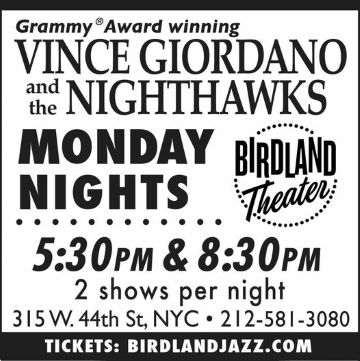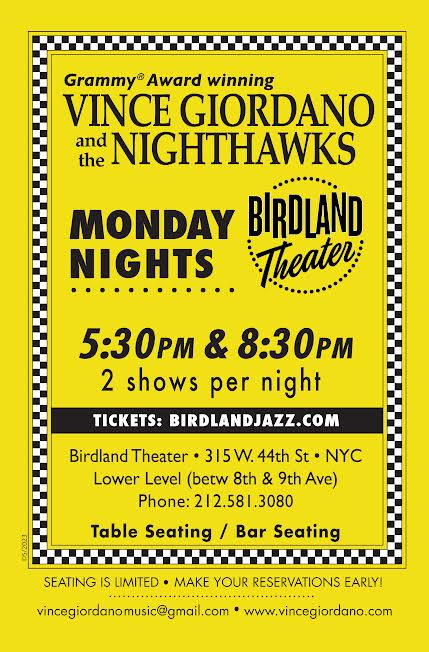GIGGLE JUICE
If you love big-band jazz and swing music played by masters, or if you are a tourist and you wish to truly feel the beat of New York’s roots, you must go to Birdland Jazz Club‘s downstairs theater and catch Vince Giordano’s concert, currently playing Mondays at 5:30 and 8:30pm. Named after saxophonist Charlie “Yardbird” Parker, Birdland is the real thing, a jazz club that exists in a time-warp, a fascinating distortion of space and time. For Vince Giordano and the Nighthawks, I felt thrown back a century just watching band members dressed in classic crisp black suits setting up, wetting the reeds, tuning the strings — all ten of them sitting very close to each other in a 1920s jazz ensemble set-up. Then Giordano took his place.
Making jokes and occasionally tossing sheet music into the air for his players to catch (and soon play), followed by enunciating the song’s corresponding numbers to make it even clearer — like a confident Bingo caller — Giordano elucidated that there is no set list (and some of these guys can no doubt play a song just by knowing the number on the sheet music). The unbelievable performers improvise with each without rehearsing it, all of them incredibly well-versed in hundreds and hundreds of tunes. We started with the “Universal Studios Fanfare”, followed by “Freeze and Melt” – written by Jimmy McHugh, first recorded by Joe Turner and His Memphis Men (a pseudonym for the Duke Ellington Orchestra) in 1929.
Vince Giordano
Giordano introduces each song with some facts; “It’s Hallelujah Time”, a great up-tempo song with an opening chorus of saxes that end up chasing each other in rocambolesque solos, punctuated by the other brass, and at the end almost collide, was written by Jo Trent in 1932. Back to the past, The Nighthawks go into a beeping and bopping “Yes! We Have No Bananas” by Frank Silver and Irving Cohn, one of the most popular and funny songs from the early 1920s, a tune that was later recorded by Benny Goodman and His Orchestra, and you can’t help imagining old cartoons like Felix the Cat dancing to it.
“Changes” written by Walter Donaldson in 1928 is the perfect vehicle to get to “Body and Soul”, the iconic jazz standard written by Johnny Green and recorded first as a jazz piece by the great Satchmo in 1930, followed by another gem of the 30s big-band swing repertoire, “Sugar Foot Stomp,” a 1925 best-selling tune by Fletcher Henderson and His Orchestra, recorded later by composers like Benny Goodman, Chick Webb, Artie Shaw, and Glenn Miller, among others.
A vein of anarchic humor runs through “You Got That Thing,” written by Cole Porter from the 1929 show Fifty Million Frenchmen and then “Nobody’s Sweetheart”, a popular song written in 1924 by Billy Meyers and Elmer Schoebel, and recorded by Louis Armstrong in 1930 and Cab Calloway & His Orchestra in 1931; “Sweet and Slow” arranged by Fats Waller and His Rhythm; “The Variety Stomp” by Fletcher Henderson and His Orchestra; and at least another three or four tunes played with the same gusto throughout. Vince asked if anybody in the audience had a favorite song for them to play, and I thought of something more recent and different from their repertoire: “Moon River” by Henry Mancini. No problem, they all knew it, and it took them ten seconds to get it together! I simply gave up, as they are unreal and unstoppable. “Vine Street Drag / I’ve Got Someone” by the Missourians, written in 1930, gloriously closed the show.
Vince Giordano and the Nighthawks promo card, courtesy of Vince Giordano
The Nighthawks: where to start in picking a favorite? Andy Stein has a distinctive musical voice, a veteran violin and baritone sax player who gave us excellent solos and introduced us to the biting sound of a phonofiddle (a stringed instrument played with a bow that uses a phonograph-type reproducer as a voice-box); Joseph Boga, a trumpet player in his early 30s who performs like an established jazz ace, a composer and arranger who has already written for brass orchestra, big band, string orchestra, choir, and jazz ensembles at his young age; and Jon-Erik Kellso on the other trumpet who brings fervor and clarity to the tunes, an older musician with a young soul who has played and recorded with Linda Ronstadt, Leon Redbone, Levon Helm, and Elvis Costello among others, appearing on over one hundred records.
In the front, Will Anderson played the alto sax and clarinet; he possesses Bobby Darin’s effortless charisma and boyish charm besides having a crafty and highly expressive way to perform. His originality shone through, as it did for Dan Levinson, sitting on his right, also playing alto sax and clarinet. Looking like a character from a film noir, Levinson smoothly juxtaposed the rhyming cadence of the silly tunes and the lyrical tenacity of the solos with extreme elegance. On his right, Mark Lopeman, tenor sax and clarinet, another jazz veteran who, as a very young man, went on the road with the Glenn Miller Orchestra and the Tommy Dorsey Orchestra before moving to New York in 1981, made us feel the fiery sensuality of both his instruments in each note he played.
Peter Yarin was impeccable at the piano and both delicate and incisive when he played the celesta with its particular bell-like timbre; Arnt Arntzen, on guitar and banjo, was enthusiastic and utterly captivating; the trombone Sam Chess and percussionist/drummer Paul Wells were both flawless and helped make the performance spellbindingly beautiful.
How to describe the bandleader, the one-of-a-kind composer/arranger Vince Giordano, a man who has collected, memorized and played more than 60,000 jazz songs? He’s jaunty, funny, incorrigible, good-natured, and is 100% in love with sharing his music (he especially loves when you bring in the youngsters). And he plays bass, tuba, piano, bass sax — and did I mention he’s funny?
The band has provided soundtracks for film and television productions including The Cotton Club, The Aviator, Finding Forrester, Revolutionary Road, Cafe Society, Boardwalk Empire, The Marvelous Mrs. Maisel, and many more. Vince also had a vocal (oh, yeah — he sings, too) in Martin Scorsese’s film, The Irishman.
Vince Giordano and the Nighthawks
Birdland Jazz Club 315 West 44th St near 8th (Times Square); 212-581-3080
Mondays at 5:30 and 8:30 (show reviewed May 6, 2024, 5:30); all-age appropriate
dinner and drinks served all night long
for more info, visit Vince Giordano



{ 4 comments… read them below or add one }
Dear Paola,
As a regular audience member, I thank you for your enthusiastic tribute to New York’s best kept secret, Vince Giordano and The Nighthawks. “Elucidate” is a good word to describe Giordano, as he respectfully sheds light on the songwriters and performers of the 1920s and 1930s.
Unfortunately, your article has a few factual errors.
“Body and Soul” was not recorded first by Louis Armstrong. Armstrong was part of a long line of bands and singers to have recorded “Body And Soul,” eight months after its first recording in 1930. The Nighthawks regularly play “It’s Hallelujah Time,” written in 1932 by Jo’ Trent, not Oscar Peterson, who wrote “Hallelujah Time” in 1963.
Cole Porter, who was impeccable in his choice of words, wrote the music and words to “You’ve Got That Thing,” not “You Got That Thing.” Somehow your article included The Rice Brothers as authors. The 1930s crooner Al Bowlly had nothing to do with the song “Changes,” the words and music of which were written by the celebrated Walter Donaldson.
The important thing is that more people learn about and enjoy this music from almost a century ago.
We were in the process of updating the review with changes offered by Mr. Giordano himself, so all corrections already made! Thanks for noticing. However, we may have to ask Mr. Giordano about the first recording of “Body and Soul”. This from KUVO JAZZ in Denver: “While in London, Johnny Green wrote ‘Body and Soul’ in 1930 for Gertrude Lawrence. Although the British Jack Hylton and His Orchestra made the first recording, it was American Paul Whiteman and His Orchestra who made the song a hit, starting as #1 on 10/11/30 and staying there for six weeks.”
It’s too long a story, but you can read the details in Will Friedwald’s “Stardust Melodies, A Biography of 12 of America’s Most Popular Songs.” There was no “Your Hit Parade” in 1930. The measure of a song’s popularity was sheet music sales, not record sales (Stock Market Crash in 1929). There was no “hit” record that year, but a few trade magazines took unofficial polls of music store dealers. More than ten U.S. dance bands and singers recorded the song that year, on every major and minor label. Johnny Green (who was a friend) did not write the song in London; he and his lyricist(s) wrote it for British entertainer Gertrude Lawrence, who took the music to London upon her return from shows in the U.S. Just because a radio station in Denver, with all due respect, posted information on the Internet does not make it a fact.
Peter Mintun is the Lord/God/King of alllll this vintage and historical music knowledge, without question.
If he says it, it IS so.
Rest assured that you are in very good musical hands when he speaks of any if this!
We Luv U, Peter!!!!